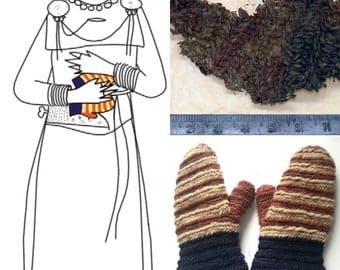Shopping Cart
- Dagfari.net
- Návody
- 2 likes
- 18057 views
- 0 comments
Knitting with the Vikings? Sure!
What and which stitch to choose? When I do it, I do it properly! Some textile techniques are as far removed from the reconstructed early medieval period as they are from the present, so we did our research.
Since knitting isn't our forte (unless you count circulars and knitting underfoot), I'm going to take it theoretical and hop, since you all know that great friend who will teach you how to knit or the wonderful crafter who will knit what you see in plain sight.
☝️A Here comes the salivating finger, frantically flipping through foreign books, which has flipped to page 1027, eighth row, bottom left.
And here it says:
knitting with one needle is generally called nålbinding, nadelbinden, naalbinding. In the Viking Age, only 4 KNITTING STYLES out of the twelve known play a major role:
FINNISH STYLE - 10th - 11th century - used, among other things, for nice warm sturdy gloves long after the Viking Age

ENGLISH YORK/JORVIK/COOPERGATE STICH - 10th century - known from a handsome low shiver found in the place after which it is named

Danish MAMMEN - 10th century - knitted here too, but with gold and silver threads

NORSE OSLO STICH - 11th century - for example a knitted glove found

⏳Some knitting styles are so far removed from the early Middle Ages that such a stitch would be as authentic as our grandmother's knitting. 1000 years here, 1000 years there - you know it if you want to do it well.
Don't be fooled by the availability and relatively low price of these artisanal living-history complete handmade by a sheep. Then and now, it costs several dozen hours to create a single piece of such a creation. The price is generally around 40 - 60 EURO (correct me in the comments if necessary) for a standard pair of ??something. If you don't want to invest that amount but have the time, learn and knit them sami♥️. The internets are full of tutorials and both boys and girls can do it ? You can buy a needle HERE . I MAKE THEM MYSELF BY HAND, I CAREFULLY CUT AND DECORATE EACH ONE AND I TAKE A DETAILED INTEREST IN THE TECHNOLOGY AND USE. SO IT IS NOT THE MASS PRODUCTION OF INDIAN AND PAKISTANI BUFFALO BONES THAT IS CURRENTLY FLOODING EUROPE DUE TO LOW PRICES!
But if I subtract the material, for example 20 EURO, and if I take into account the production of 15 - 30 hours, then 1 - 2 EURO per hour is still quite little.
Maybe that's why in the Middle Ages they usually knitted only small pieces of textiles, big things like sweaters etc would not be so worth making from other material. The price of the product is further increased by using hand spun wool and not machine spun, naturally dyed wool and not chemical and also wool that doesn't bite like a ⚡Monster.
So here too, they were in a rich grave and on a poorer stratum, a replica of such colours would not be applauded ? If you are more of a worker, avoid blue and red!
ℹ️ When you hit your sock maker with unexpected knowledge and want a particular knitting style from the four you've chosen, so that your most expensive socks ever are as LH as they can be, prepare for a potentially higher price. Both because of the difficulty of the knitting style and the different material consumption of each style.
As the saying goes - when two people do the same thing.. so one will have a cheaper sock in a simpler style and bulk it up on the treadmill so to speak, and the other will play with it, often testing and remeasuring (because this knitting style is irreversibly strong and can't be unravelled or expanded much) and make it out of more expensive, authentic material, and the price will match that.
❓ What you choose is up to you. We generally recommend undyed, brown, light colors. But you can alternate shades and historical colors, like on a glove from Finland ? By the way - some chic girls will add an extra heel insert on the socks, in case you get a puncture, just to change the patch! Cool! More expensive! LH!
✈️V throughout the ages, even from before the Vikings, such socks and gloves were worn by, for example, the Egyptians (yes, hence the Roman and Bohemian wearing of socks in sandals - I guess it's become widespread here since we started traveling to Egypt and bringing back diarrhea and socks in sandals). You can also find these stitches in Peru, China and Israel. I'm sure those naalbinding needles were delivered by aliens!

♨️ A typical feature of this archaeologically documented knitting style is that it does not unravel. When worn, it is stiffened, knitted together and the relatively fragile yarn is made into warm clothing, sometimes reinforced with horsehair or animal hair.
So it seems that gloves and socks, some fingerless arm warmers or taller socks are OK.
And now for the damn hat. It's such a bad.. unpleasant, controversial thing and a very tricky subject.
What is commonly found on the heads of reenactors actually stems from the discovery of a very well preserved cap, which has become a church relic and is therefore so well maintained. And now comes the controversial BUT.
The ONE and therefore rare cap is from the tomb of SAINT Simeon of Trier, Germany.
As it is commonly presented - a simple circular knitted cap - it is basically a thorn in the side of those who would like to see the revived history ⚖️ balanced and items that have only been found in one piece and still in atypical graves are recommended to be worn more as a rarity and not made into a top product for all fencers.
In the picture you can see the lining for reinforcement, the hem and it supposedly had a silver tip. Its peculiarity is also created by the fact that the holy man lived in Palestine in the Middle East for many years and that is where this cap is said to have originated. Does it remind us of a yarmulke? Was it supposed to cure headaches? When the Buddha statue was found in Birka, will we all wear it too? Who knows? ?
But we know that St. Simeon was a true saint, living a very strict ascetic life, and this cap was a very simple part of the equipment of a poor saint in his design, which even got walled up in the church. Its use, therefore, may be at the mercy of the poorer craftsmen or those who represent the Christians of the early Middle Ages, and that every one else should wear it, and improve it with colour and decoration, cannot be recommended until another foundation for such a cap is found.
So ?It's up to you whether you use your knowledge of a bunch of other early medieval headgear, such as common cloth caps and ladies' scarves, or whether you live with what you have now or what you bulletproof. Because a knitted hat is still better than no hat ?
✅ Our goal is not to criticize someone for their equipment, but rather not to hide anything that may have escaped the attention of experienced fencers. We all have some sort of overarching interest in our hobby, and when it's fighting or cooking, for example, one can hardly ask to be a knitting expert. You just buy and don't freeze. It's just that sometimes you just want to go the extra mile and get it right the first time, as they say. And also to know what to say to a visitor when they ask about those weird socks.
Dagfari.net also aims to be able to help newcomers avoid unnecessary purchases and to advise them from the start how to equip themselves according to the latest information from the world of early medieval reconstruction. Nobody downloads Internet Explorer now ? Those who have just arrived can read the previous posts, where we explained what fabric to buy to create a costume for the poorer and middle classes and what pattern to make easily at home.
Soon we'll sketch some textile headgear for men and women, because covering the head is a typical part of the culture we want to present and in the meantime we are preparing an article about shoes and also a tutorial on how to make your own shoes!
So stay tuned, keep adding information for all of us in the comments and let's get ready together for more topics to be rolled out for the start of Rogar - Early Medieval Battle 2025!
And now for the cheapest and most authentic tip!




Comments (0)